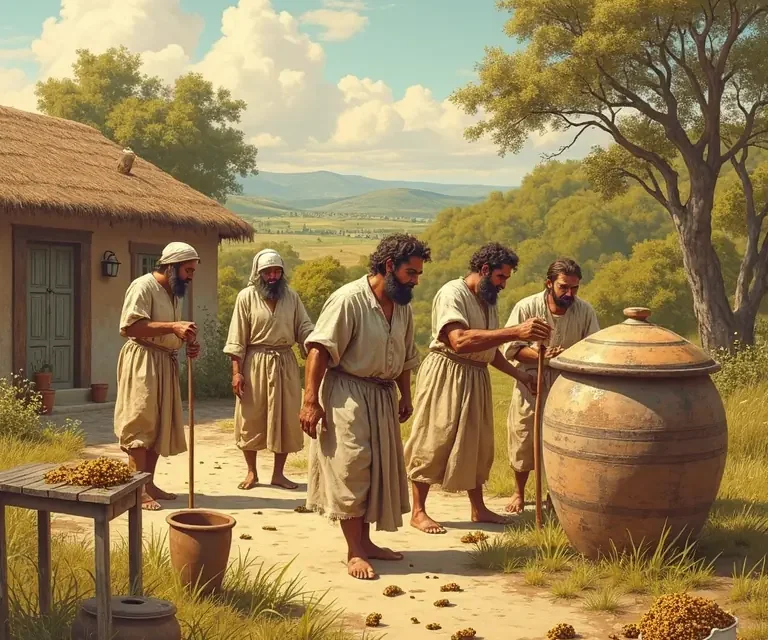For millennia, humans have been fascinated by the rhythm of time. From the predictable movements of the sun and stars to the cyclical changes of seasons, our ancestors sought ways to measure, understand, and ultimately, control the passage of time. While sundials, water clocks, and hourglasses are often cited as the earliest timekeeping devices, a less-known – and surprisingly effective – method relied on the diligent work of honeybees. This article delves into the fascinating history of using bees for timekeeping in ancient civilizations, exploring the scientific basis behind the practice, its cultural significance, and its eventual decline.
A Buzzing History: Early Observations of Bee Behavior
The connection between bees and timekeeping isn’t a recent discovery. Observations of bee behavior date back to ancient Egypt, Mesopotamia, and even pre-Columbian America. These cultures weren’t simply admiring the honeybees’ industriousness; they were keenly observing patterns in their daily activities, particularly their flight times and the construction of their honeycombs. Early naturalists and priests noticed that bees consistently emerged from their hives and returned at relatively predictable intervals, influenced by the sun’s position and the time of day. This regularity wasn’t attributed to a sophisticated internal clock within the bees themselves (though we now know they possess complex biological rhythms), but rather to a sensitivity to external cues – primarily sunlight.
The earliest written records suggesting the use of bees for timekeeping come from ancient Egypt. Hieroglyphs depict beekeepers meticulously observing bee flight patterns, and texts mention the practice of using bees to mark the passing of hours. While specific details are scarce, it’s believed that priests and officials employed designated ‘bee-watchers’ whose sole duty was to monitor bee activity and announce the time based on their observations. This system, while seemingly rudimentary, provided a relatively accurate and accessible means of timekeeping, especially during periods when more complex devices were unavailable or impractical.
The Science Behind the Buzz: How Bees Tell Time
But how could bees actually *tell* time? The answer lies in the way bees perceive and respond to light. Bees possess compound eyes capable of detecting polarized light, a phenomenon invisible to the human eye. Polarized light patterns change throughout the day as the sun moves across the sky. Bees use these patterns, along with the intensity of sunlight, to navigate and determine the time. Essentially, bees act as natural light sensors, providing a living, breathing indication of the time of day.
This sensitivity to light is crucial for their foraging behavior. Bees are most active during specific periods of daylight, coinciding with optimal conditions for nectar collection. They have an internal biological clock, but this clock is *synchronized* with the external environment, particularly the sun’s position. Therefore, the time they leave and return to the hive is not merely dictated by an internal schedule, but by the external light conditions.
Furthermore, the temperature also plays a role. Bees are ectothermic (cold-blooded), meaning their body temperature is regulated by the environment. Temperature fluctuations influence their activity levels, and these fluctuations are also predictable throughout the day. Combining observations of both light and temperature, ancient timekeepers could create a fairly accurate system for dividing the day into hours.
Egyptian Bee Time: A Detailed Look at the Practice
In ancient Egypt, the practice of bee-based timekeeping was deeply integrated into religious and administrative life. The sun god Ra was often associated with bees, and their diligent work was seen as a reflection of divine order. Temples, in particular, relied on accurate timekeeping for scheduling rituals and ceremonies. Bee-watchers were likely attached to these temples, responsible for announcing the hours using a system based on bee flight patterns.

The exact method used by the Egyptians is debated, but several theories exist. One suggests that the time was determined by the moment when a certain percentage of bees left the hive for foraging. Another proposes that the time was calculated based on the distance bees flew from the hive within a specific timeframe. Regardless of the precise methodology, the system required skilled observers and a deep understanding of bee behavior. It also necessitated consistency in hive management – maintaining healthy hives and ensuring a stable bee population were crucial for reliable timekeeping.
Archaeological evidence, while limited, supports the idea of sophisticated beekeeping practices in ancient Egypt. Excavations have uncovered remnants of beehives and tools used for honey extraction, indicating a well-developed apiculture industry. This industry wasn’t solely focused on honey production; it also served a vital role in timekeeping and religious practices.
Beyond Egypt: Bees in Mesopotamian and Other Cultures
While Egypt is perhaps the most well-documented example, the use of bees for timekeeping wasn’t confined to the Nile Valley. In Mesopotamia, similar observations of bee behavior were recorded in cuneiform texts. Although the details are less clear than in the Egyptian accounts, it appears that Mesopotamian priests also employed bee-watchers to mark the passage of time. The association of bees with goddesses of fertility and abundance further suggests their cultural significance.
Evidence also suggests that pre-Columbian civilizations in the Americas utilized bee behavior for timekeeping. The Maya, for instance, were renowned for their advanced astronomical knowledge and calendrical systems. While their primary method of timekeeping involved sophisticated astronomical observations, some researchers believe that they also incorporated observations of bee activity into their daily routines. The stingless bees native to the Americas were particularly well-suited for this purpose, as they are active throughout the day and exhibit predictable foraging patterns.
The Rise of Mechanical Timekeeping and the Decline of Bee Time
The reliance on bees for timekeeping gradually declined with the development of more accurate and reliable mechanical devices. The invention of sundials, water clocks, and eventually, mechanical clocks, offered a more precise and independent means of measuring time. These devices weren’t subject to the vagaries of weather or bee behavior, and they could be used in a wider range of environments.
The development of the escapement mechanism in medieval Europe revolutionized timekeeping. This innovation allowed for the creation of increasingly accurate mechanical clocks, which eventually became commonplace in churches, town halls, and private homes. As mechanical clocks became more accessible, the need for bee-watchers diminished, and the ancient practice of bee-based timekeeping faded into obscurity.

However, the legacy of bee time remains. It serves as a reminder of the ingenuity of our ancestors and their ability to harness the natural world for practical purposes. It also highlights the importance of observation and understanding the rhythms of nature. The practice also demonstrates the interconnectedness of culture, science, and the environment in ancient societies.
The Cultural Significance of Bees and Time
Beyond their practical application in timekeeping, bees held a significant cultural and symbolic meaning in many ancient civilizations. They were often associated with concepts such as diligence, community, and immortality. The intricate organization of a beehive was seen as a model for human society, and the production of honey was viewed as a sacred act. The association of bees with hard work is still reflected in our language today.
In ancient Egypt, the bee was a symbol of Lower Egypt and represented the ruler’s power and authority. In Greek mythology, bees were associated with the Muses, goddesses of the arts and sciences. The Romans also revered bees, and they were often depicted on coins and other artifacts. This widespread reverence for bees underscores their importance in the cultural landscape of the ancient world.
Bee Time and the Evolution of Unit Measures
Interestingly, the practice of bee timekeeping may have also influenced the development of early unit measures. The consistent intervals observed in bee behavior could have provided a natural standard for dividing the day into hours and minutes. The concept of dividing time into equal parts may have been inspired by the regular patterns observed in the natural world, including the activities of bees. The evolution of measurement systems is a complex topic, but bee time may have played a subtle yet important role in its development.
The Legacy Continues: Modern Apiculture and the Study of Bee Behavior
While bee timekeeping is no longer a widespread practice, the study of bee behavior continues to fascinate scientists and researchers. Modern apiculture, the scientific study of bees, has revealed a wealth of information about their complex social structures, navigational abilities, and biological rhythms. The medicinal properties of honey and other bee products have also been extensively studied, and these products are used in a variety of traditional and modern remedies.
Furthermore, the principles of swarm intelligence, inspired by the collective behavior of bees, are being applied to solve complex problems in fields such as robotics, computer science, and logistics. The ability of bees to collectively make decisions and optimize their foraging behavior has proven to be a valuable model for developing intelligent systems.
Looking Back: A Unique Chapter in the History of Timekeeping
The story of bees in ancient timekeeping is a unique and often overlooked chapter in the history of science and technology. It demonstrates the resourcefulness of our ancestors and their ability to find innovative solutions to practical problems using the natural world around them. While mechanical clocks and digital devices now dominate our modern lives, it’s important to remember the humble beginnings of timekeeping and the surprising role played by these industrious insects. The next time you see a bee buzzing around a flower, remember that it’s not just collecting nectar; it’s also a living reminder of a time when bees helped humanity measure the passage of time.
The Importance of Precision: Timekeeping and Punctuation
The quest for accurate timekeeping has always been linked to the need for precise communication. Just as accurate timekeeping requires careful observation and measurement, clear communication requires the use of standardized symbols and conventions. The development of punctuation marks, for example, was crucial for clarifying the meaning of written texts and ensuring that messages were understood as intended. The desire for precision in timekeeping and communication reflects a fundamental human need for order and clarity.
Automata and the Pursuit of Mechanical Time
The development of mechanical timekeeping devices also paved the way for the creation of elaborate automata – self-operating machines designed to mimic human or animal behavior. These mechanical marvels often incorporated intricate clockwork mechanisms, demonstrating the ingenuity and skill of early engineers. The pursuit of mechanical timekeeping not only provided a more accurate way to measure time but also inspired the creation of increasingly sophisticated mechanical devices.


 The Surprisingly Durable Legacy of Ancient Roman Concrete
The Surprisingly Durable Legacy of Ancient Roman Concrete  The Lost Art of Navigation by the Stars: How Ancient Sailors Charted the Seas
The Lost Art of Navigation by the Stars: How Ancient Sailors Charted the Seas